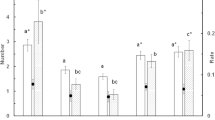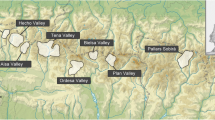Abstract
The 71 species of horseshoe bat (genus Rhinolophus) use echolocation calls with long constant-frequency (CF) components to detect and localize fluttering insects which they seize in aerial captures or glean from foliage. Here we describe ground-gleaning as an additional prey-capture strategy for horseshoe bats. This study presents the first record and experimental evidence for ground-gleaning in the little-studied Blasius’ horseshoe bat (Rhinolophus blasii). The gleaning bouts in a flight tent included landing, quadrupedal walking and take-off from the ground. The bats emitted echolocation calls continuously during all phases of prey capture. Both spontaneously and in a choice experiment, all six individuals attacked only fluttering insects and never motionless prey. These data suggest that R. blasii performs ground-gleaning largely by relying on the same prey-detection strategy and echolocation behaviour that it and other horseshoe bats use for aerial hawking.
We also studied the Mediterranean horseshoe bat (R. euryale) in the flight tent. All four individuals never gleaned prey from the ground, though they appeared to be well able to detect fluttering moths on the ground. It is not known yet whether ground-gleaning plays a role in Mehely’s horseshoe bat (R. mehelyi). In a performance test, we measured the ability of these three European species of “middle-sized” horseshoe bats (R. euryale, R. mehelyi and R. blasii) to take-off from the ground. All were able to take flight even in a confined space; i.e. the willingness to ground-glean in R. blasii is not related to a superior take-off performance. In contrast to ground-gleaning bats of other phylogenetic lineages, R. blasii appears not to be a specialist, but rather shows a remarkable behavioural flexibility in prey-capture strategies and abilities. We suggest that the key innovation of CF echolocation paired with behavioural flexibility in foraging strategies might explain the evolutionary success of Rhinolophus as the second largest genus of bat.



Similar content being viewed by others
References
Arlettaz R, Jones G, Racey PA (2001) Effect of acoustic clutter on prey detection by bats. Nature 414:742–745
Bell GP, Fenton MB (1984) The use of doppler-shifted echoes as a flutter detection and clutter rejection system: the echolocation and feeding behavior of Hipposideros ruber (Chiroptera: Hipposideridae). Behav Ecol Sociobiol 15:109–114
Blackmore M (1964) Order Chiroptera. In: Suthers NH (ed) The handbook of British mammals. Blackwell, Oxford, pp 224–249
Boonman AM, Boonman M, Bretschneider F, Grind WAvd (1998) Prey detection in trawling insectivorous bats: duckweed affects hunting behavior in Daubenton’s bat, Myotis daubentonii. Behav Ecol Sociobiol 44:99–107
Csorba G, Ujhelyi P, Thomas N (2003) Horseshoe bats of the world. Alana Books
Faure PA, Barclay RMR (1994) Substrate-gleaning versus aerial-hawking: plasticity in the foraging and echolocation behaviour of the long-eared bat, Myotis evotis. J Comp Physiol A 174:651–660
Fenton MB (1990) The foraging behaviour and ecology of animal-eating bats. Can J Zool 68:411–422
Fenton MB, Gaudet CL, Leonard ML (1983) Feeding behaviour of the bats Nycteris grandis and Nycteris thebaica (Nycteridae) in captivity. J Zool Lond 200:347–354
Fenton MB, Swanepoel CM, Brigham RM, Cebek JE, Hickey MBC (1990) Foraging behavior and prey selection by large silt-faced bats (Nycteris grandis; Chiroptera: Nycteridae). Biotropica 22:2–8
Fryxell JM (1997) Evolutionary dynamics of habitat use. Evol Ecol 11:687–701
Fuzessery ZM, Buttenhoff P, Andrews B, Kennedy JM (1993) Passive sound localization of prey by the pallid bat (Antrozous pallidus). J Comp Physiol A 171:767–777
Gaisler J (2001) Rhinolophus mehelyi Matschie, 1901—Mehelyi Hufeisennase. In: Niethammer J, Krapp F (eds) Handbuch der Säugetiere Europas. Aula, Wiebelsheim, pp 91–104
Goiti U, Aihartza JR, Garin I, Zabala J (2003) Influence of habitat on the foraging behaviour of the Mediterranean horseshoe bat, Rhinolophus euryale. Acta Chiropt 5:75–84
Griffin DR, Simmons JA (1974) Echolocation of insects by horeshoe bats. Nature 250:731–732
Heblich K (1986) Flügelschlag und Lautaussendung bei fliegenden und landenden Fledermäusen. In: Nachtigall W (ed) Biona Report 5. Fischer, Stuttgart, pp 139–156
Henein K, Wegner J, Merriam G (1998) Population effects of landscape model manipulation on two behaviourally different woodland small mammals. Oikos 81:168–186
Jones G, Rayner JMV (1989) Foraging behavior and echolocation of wild horseshoe bats Rhinolophus ferrumequinum and R. hipposideros (Chiroptera, Rhinolophidae). Behav Ecol Sociobiol 25:183–191
Kalko EKV, Friemel D, Handley COJr, Schnitzler H-U (1999) Roosting and foraging behavior of two neotropical gleaning bats, Tonatia silvicola and Trachops cirrhosus (Phyllostomidae). Biotropica 31:344–353
Kock D, Howell KM (1988) Three new bats for mainland Tanzania (Mammalia: Chiroptera). Senckenbergiana Biol 68:223–239
Krystufek B, Dulic B (2001) Rhinolophus blasii Peters, 1866—Blasius’ Hufeisennase. In: Niethammer J, Krapp F (eds) Handbuch der Säugetiere Europas. Aula, Wiebelsheim, pp 75–90
Kulzer E, Nelson JE, McKean JL, Moehres FP (1984) Prey-catching behavior and echolocation in the australian ghost bat, Macroderma gigas (Microchiroptera: Megadermatidae). Aust Mammal 7:37–50
Marimuthu G, Neuweiler G (1987) The use of acoustical cues for prey detection by the Indian false vampire bat, Megaderma lyra. J Comp Physiol A 160:509–515
Mayr E (1965) The nature of colonizations in birds. In: Baker HG, Stebbins L (eds) The genetics of colonizing species. Academic, New York, pp 29–43
McDonald JT, Rautenbach IL, Nel JAJ (1990) Foraging ecology of bats observed at De Hoop Provincial Nature Reserve, southern Cape Province. S Afr J Wildl Res 20:133–145
Metzner W, Zhang S, Smotherman M (2002) Doppler-shift compensation behavior in horseshoe bats revisited: auditory feedback controls both a decrease and an increase in call frequency. J Exp Biol 205:1607–1616
Miller AH (1956) Ecological factors that accelerate formation of races and species of terrestrial vertebrates. Evolution 10:262–277
Neuweiler G (1990) Auditory adaptations for prey capture in echolocating bats. Physiol Rev 70:615–641
Neuweiler G, Metzner W, Heilmann U, Rübsamen R, Eckrich M, Costa HH (1987) Foraging behaviour and echolocation in the rufous horseshoe bat (Rhinolophus rouxi) of Sri Lanka. Behav Ecol Sociobiol 20:53–67
Nicolakakis N, Sol D, Lefebvre L (2003) Behavioural flexibility predicts species richness in birds, but not extinction risk. Anim Behav 65:445–452
Nowak RM (1994) Walker’s bats of the world. John Hopkins University Press, Baltimore
Pavey CR (1998) Habitat use by the eastern horseshoe bat, Rhinolophus megaphyllus, in a fragmented woodland mosaic. Wildl Res 25:489–498
Popov VV, Ivanova TI (2002) Comparative craniometrical analysis and distributional patterns of medium-sized horseshoe bats (Chiroptera : Rhinolophidae) in Bulgaria. Folia Zool 51:187–200
Ratcliffe JM, Dawson JW (2003) Behavioural flexibility: the little brown bat, Myotis lucifugus, and the northern long-eared bat, M. septentrionalis, both glean and hawk prey. Anim Behav 66:847–856
Russo D, Jones G, Migliozzi A (2002) Habitat selection by the Mediterranean horseshoe bat, Rhinolophus euryale (Chiroptera: Rhinolophidae) in a rural area of southern Italy and implications for conservation. Biol Conserv 107:71–81
Ryan MJ, Tuttle MD, Barclay RMR (1983) Behavioral responses of the frog-eating bat, Trachops cirrhosus, to sonic frequencies. J Comp Physiol A 150:413–418
Rydell J, Miller LA, Jensen ME (1999) Echolocation constraints of Daubenton’s bat foraging over water. Funct Ecol 13:247–255
Schmidt S, Türke B, Vogler B (1984) Behavioural audiogram from the bat, Megaderma lyra (Geoffroy, 1810; Microchiroptera). Myotis 21/22:62–66
Schnitzler HU (1968) Die Ultraschall-Ortungslaute der Hufeisen-Fledermäuse (Chiroptera-Rhinolophidae) in verschiedenen Ortungssituationen. Z Vgl Physiol 57:376–408
Schnitzler HU (1971) Fledermäuse im Windkanal. Z Vergl Physiol 73:209–221
Schnitzler HU (1983) Fluttering target detection in horseshoe bats. J Acoust Soc Am 74:31
Schnitzler HU, Kalko EKV (2001) Echolocation by insect-eating bats. BioScience 51:557–569
Schnitzler HU, Hackbarth H, Heilmann U, Herbert H (1985) Echolocation behavior of rufous horseshoe bats hunting for insects in the flycatcher-style. J Comp Physiol A 157:39–46
Schnitzler HU, Moss CF, Denzinger A (2003) From spatial orientation to food acquisition in echolocating bats. Trends Ecol Evol 18:386–394
Schober W, Grimmberger E (1998) Die Fledermäuse Europas. Kosmos, Stuttgart
Shortridge GC (1934) The mammals of south west Africa. Heinemann, London
Siemers BM, Schnitzler HU (2000) Natterer’s bat (Myotis nattereri Kuhl, 1818) hawks for prey close to vegetation using echolocation signals of very broad bandwidth. Behav Ecol Sociobiol 47:400–412
Siemers BM, Schnitzler HU (2004) Echolocation signals reflect niche differentiation in five sympatric congeneric bat species. Nature 429:657–661
Siemers BM, Stilz P, Schnitzler HU (2001) The acoustic advantage of hunting at low heights above water: behavioural experiments on the European “trawling” bats Myotis capaccinii, M. dasycneme and M. daubentonii. J Exp Biol 204:3843–3854
Sol D, Timmermans S, Lefebvre L (2002) Behavioural flexibility and invasion success in birds. Anim Behav 63:495–502
Swift SM, Racey PA (2002) Gleaning as a foraging strategy in Natterer’s bat Myotis nattereri. Behav Ecol Sociobiol 52:408–416
Tian B, Schnitzler HU (1997) Echolocation signals of the greater horseshoe bat (Rhinolophus ferrumequinum) in transfer flight and during landing. J Acoust Soc Am 101:2347–2364
Trappe M, Schnitzler HU (1982) Doppler-shift compensation in insect-catching horseshoe bats. Naturwissenschaften 69:193
Vaughan TA (1976) Nocturnal behavior of the African false vampire bat (Cardioderma cor). J Mammal 57:227–248
Vogler B, Neuweiler G (1983) Echolocation in the noctule (Nyctalus noctula) and horseshoe bat (Rhinolophus ferrumequinum). J Comp Physiol A 152:421–432
Whitaker JO Jr, Black H (1976) Food habits of cave bats of Zambia, Africa. J Mammal 57:199–204
Acknowledgements
We thank Ivailo Borissov, Christian Dietz, Isabel Schunger and Dietmar Nill for help in the field, and Svetlana Miteva, Christo Christov and Elena Bojinova for hospitality and help at the Madjaruvo Vulture Center field station. Dr. Stojan Beshkov kindly determined species identity of the moth remains. We thank Christoph König and Ingrid Kaipf for excellent technical assistance, as well as Klemen Koselj, Christian Dietz and Dr. Arjan Boonman for discussion. We gratefully acknowledge the valuable comments by Drs. Danilo Russo, Brock Fenton and an anonymous referee that helped to improve the manuscript. Our research was funded by a special project grant from the University of Tübingen and by the Deutsche Forschungsgemeinschaft (DFG Si 816/2-1). The study was performed with permission from the responsible Bulgarian authorities and experiments complied with Bulgarian laws.
Author information
Authors and Affiliations
Corresponding author
Additional information
Communicated by T. Czeschlik
Rights and permissions
About this article
Cite this article
Siemers, B.M., Ivanova, T. Ground gleaning in horseshoe bats: comparative evidence from Rhinolophus blasii, R. euryale and R. mehelyi . Behav Ecol Sociobiol 56, 464–471 (2004). https://doi.org/10.1007/s00265-004-0807-4
Received:
Revised:
Accepted:
Published:
Issue Date:
DOI: https://doi.org/10.1007/s00265-004-0807-4




